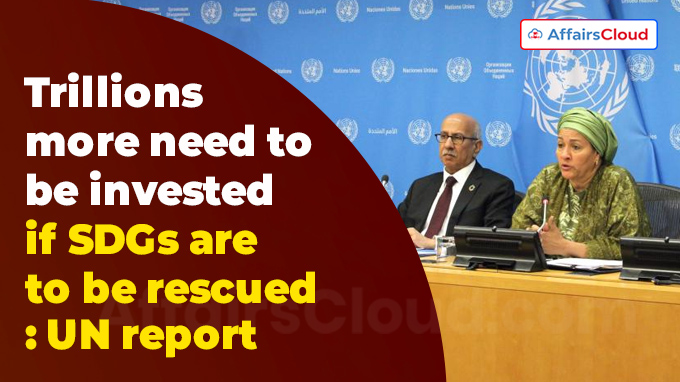 On 9th April 2024, the United Nations Department of Economic and Social Affairs (UN DESA) released the 9th edition of ‘Financing for Sustainable Development Report 2024 (FSDR 2024)-Inter-agency Task Force on Financing for Development‘ on the theme ‘Financing for Development at a Crossroads’.
On 9th April 2024, the United Nations Department of Economic and Social Affairs (UN DESA) released the 9th edition of ‘Financing for Sustainable Development Report 2024 (FSDR 2024)-Inter-agency Task Force on Financing for Development‘ on the theme ‘Financing for Development at a Crossroads’.
- As per it, to overcome or close the development financing gap, an estimated USD 4.2 trillion in investments are required, as compared to USD 2.5 trillion before the onset of the COVID-19 pandemic.
- The report highlights the necessity of economic transitions for achieving sustainable development goals (SDGs) which will require investments at unprecedented scale.
Who prepared the report?
i.This report is a joint product of the members of the Inter-agency Task Force on Financing for Development (IATF), comprised of more than 60 UN agencies and international organizations.
ii.The Financing for Sustainable Development Office of UN DESA serves as the coordinator and substantive editor of FSDR in close cooperation with the World Bank Group, the International Monetary Fund (IMF), the World Trade Organization (WTO), the UN Conference on Trade and Development (UNCTAD), the UN Development Programme (UNDP), and the UN Industrial Development Organization (UNIDO).
Highlights:
i.The report advocates for a financial system that boosts investment in SDGs and adapts swiftly to crises.
ii.Financing gaps were substantial even before 2020 but grew significantly due to the COVID-19 pandemic and subsequent shocks.
iii.Rising debt burdens and borrowing costs are major contributors, undoing development progress, especially in the poorest nations.
iv.Debt servicing costs for Least Developed Countries (LDCs) are estimated at USD 40 billion between 2023 and 2025, up over 50% i.e. USD 26 billion from 2022.
- The median debt service burden for LDCs surged from 3.1% of revenue in 2010 to 12% in 2023, the highest since 2000.
v.Notably, about 3.3 billion people, roughly 40% of the world’s population, reside in countries where government spending on interest payments exceeds that on education or health.
- LDCs spend 12% of their revenues on interest payments.
vi.Climate change-related disasters account for over half of the debt increase in vulnerable nations.
vii.Official Development Assistance (ODA) from Organisation for Economic Co-operation and Development (OECD) countries reached USD 211 billion in 2022, up from USD 185.9 billion in 2021, but still insufficient for development.
viii.Only four countries viz. Luxembourg, Sweden, Norway, and Germany met the 0.7% of gross national income (GNI) target for aid in 2022.
ix.With six years left to achieve the SDGs, progress is declining, especially in the poorest countries. If things don’t change, the UN expects almost 600 million people to still live in extreme poverty by 2030, over half of them women.
Additional info:
i.The report points to the UN Summit of the Future in September 2024 as a crucial opportunity to change course.
ii.It highlights the 4th International Conference on Financing for Development (FfD4) which will be held 30th June to 3rd July 2025 in Spain, as the critical moment for countries to commit to closing the development financing gap and invest in achieving the SDGs.
iii.The report forms the basis for discussions at the UN Economic and Social Council (ECOSOC) Forum on Financing for Development, where Member States discuss measures necessary to mobilize sustainable financing.
iv.The report also informs the SDG Investment Fair, a platform which brings together government officials and investors for sustainable investment opportunities that support the achievement of the SDGs.
List of 17 SDGs:
| Goal | Title |
|---|---|
| 1 | No Poverty |
| 2 | Zero Hunger |
| 3 | Good Health and Well-being |
| 4 | Quality Education |
| 5 | Gender Equality |
| 6 | Clean Water and Sanitation |
| 7 | Affordable and Clean Energy |
| 8 | Decent Work and Economic Growth |
| 9 | Industry, Innovation, and Infrastructure |
| 10 | Reduced Inequality |
| 11 | Sustainable Cities and Communities |
| 12 | Responsible Consumption and Production |
| 13 | Climate Action |
| 14 | Life Below Water |
| 15 | Life on Land |
| 16 | Peace, Justice, and Strong Institutions |
| 17 | Partnerships for the Goals |
These goals, adopted by all United Nations Member States in 2015 as part of the 2030 Agenda for Sustainable Development, aim to address global challenges and ensure a better future for all.
Recent Related News:
i.On 31 January 2024, India contributed USD 32.895 million (approximately Rs. 273 Crore) to the UN Regular Budget (RB) for 2024 and earned its spot in the “Honour Roll of the UN for 2024.
ii.On February 12, 2024, the first-ever ‘State of the World’s Migratory Species‘ report was launched at the 14th Meeting of the Conference of the Parties to the Convention on the Conservation of Migratory Species of Wild Animals (CMS COP14), also known as Bonn Convention in Samarkand, Uzbekistan from February 12-17, 2024.
About United Nations Department of Economic and Social Affairs (UN DESA):
The Under-Secretary-General (USG) for Economic and Social Affairs, appointed by the UN Secretary-General, is the head of UN DESA.
Head– USG Li Junhua
Headquarters– New York, United States (US)
Establishment– 1948




